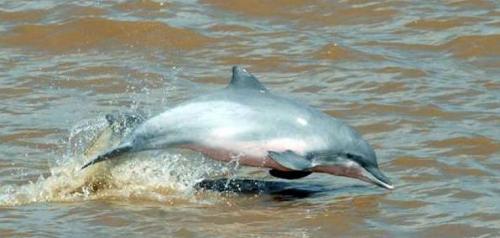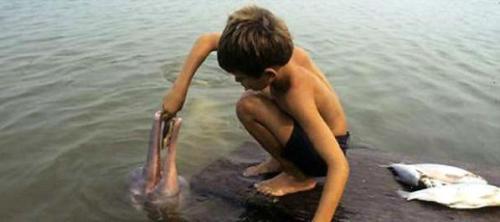|
River Dolphins in South America Bolivia hosted a week long trip along the rivers Ichilo (Santa Cruz and Cochabamba) and Mamoré (Beni), as a part of the River Dolphin Monitoring Initiative for South America, a year long joint effort carried out by Omacha Foundation (Colombia), The Wildlife Conservation Society (WCS), Whale and Dolphin Conservation Society (WDCS) and WWF Colombia in the Amazon and Orinoco watersheds: Ecuador, Peru, Bolivia, Brazil, Colombia and Venezuela. In July, in coordination with the Bolivian General Management for Biodiversity, Faunagua and WWF Bolivia, the Itenez River (Beni, Bolivia) will be the last leg of this continental river dolphin monitoring effort.
Photo © Francois Xavier PELLETIER and Text WWFolio (WWF Bolivia All Rights Reserved)
In Venezuela (June, 2006) the results of the expedition observed 270 Dolphins, while in Ecuador (July, 2006) 40 were sighted. The results for Colombia (August, 2006) reported 131 River dolphins (Inia geoffrensis); in Peru (September 2006) 818 were reported for both River dolphin (Inia geoffrensis) and Tucuxi (Sotalia fluviatilis). During the 240 km trip along the Amazonas, Atacuarí and Javarí rivers, between Colombia, Brazil and Peru (February, 2007), the group of scientists from Omacha Foundation spotted 520 Dolphins and expressed that the results obtained from previous expeditions indicate that the population of Dolphin in the Amazon River is healthier versus the one in the Orinoco River. In spite of healthy population, the census along the Amazon River did expose the serious threats that directly affect this ecosystem. The drastic deforestation process caused by illegal logging and burning, as well as infrastructure development projects, added to contamination and climate change, are rapidly destroying the most important extension of natural forest in the world. River dolphins, referred to in Bolivia as ‘Bufeos’, are one of the most threatened aquatic mammals worldwide, mainly because of the negative interaction with fishing and deterioration of their habitat caused by the construction of hydroelectric plants, mercury and hydrocarbon pollution, as well as large scale deforestation – all of which directly affect the presence and distribution of fish (which the River dolphin depend on as their food source). The conservation status of River dolphins is therefore also an indicator of the conservation status of the regions themselves where they inhabit, which are rich in biodiversity and of great importance for maintaining a global ecological balance. According to Mr. Saulo Usma, Freshwater Programme Coordinator for WWF Colombia, “the conclusion of the census in Bolivia generates great expectations since there is also a different species, Inia boliviensis, and this will be the first opportunity for studying the species”. “With the census in Bolivia we will have concrete results regarding the status of the River dolphin populations in the Orinoco and Amazon watersheds and, most importantly, we will consolidate the necessary information in order to implement a conservation strategy for this emblematic species”. Getting to know the Inia boliviensisRiver dolphins were discovered by the French researcher Alcides D'Orbigny in 1832, during his last trip to South America when he traveled along the Iténez River (Beni). At that time, D’Orbigny named this Dolphin Inia boliviensis, species that later on was given the name Inia geoffrensis. The Pink dolphin or Bufeo is the largest freshwater Dolphin in the world. It can reach up to 2.8 m long and weigh 180 kg. In Latin America, this species is widely distributed in the Amazon and Orinoco watersheds (Colombia, Venezuela, Brazil, Bolivia, Ecuador and Peru). In Bolivia, it is found in Amazon Watershed rivers in the departments of Cochabamba, Santa Cruz, Beni and Pando. The rocky irregularities – known as ‘cachuelas’ – along the Madeira River – only a few kilometers from where the Mamoré River meets the Beni River – have isolated the Bufeo in Bolivia, making its evolution as a species different from Inia geoffrensis possible: the Inia boliviensis. Scientists have found that this Bolivian species has more teeth, a larger body and a smaller scull, compared to Inia geoffrensis. Thus, currently there are two identified Pink dolphin species: Inia boliviensis and Inia geoffrensis. This latter has two subspecies: Inia geoffrensis geoffrensis in the Amazon and Inia geoffrensis humboldtiana in the Orinoquia. 
The Inia boliviensis is an endemic species of the Upper Madeira River Watershed, mainly found in Bolivia (Madeira is the river that conducts the Bolivian waters to the Amazon). This species is very showy and has potential for becoming an emblematic species for the region, as a tourism and conservation ambassador. Read more about WWF Bolivia's work with river dolphins in Bolivia here. Click the panda to return to our wildlife home page.     |

